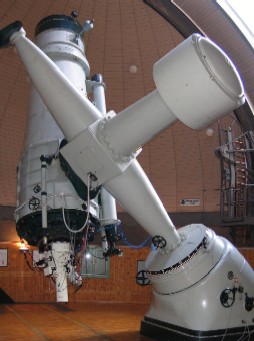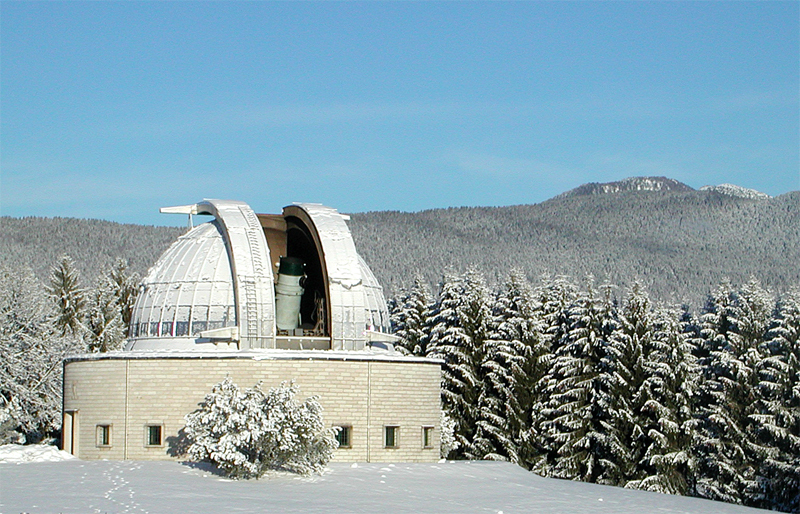Asiago 1.22m telescope
 The Asiago 1.22m telescope belongs to the University of Padova, is located 1045 meters above the sea-level in the pre-Alps (longitude E11° 31'
35" — latitude +45° 51' 59"), opened in 1942 and has a classic Cassegrain design on an English-type mount. On various epochs it has been fully
refurbished to keep it updated with evolving technology, and it is operated only remotely (with site staff for maintenance). A Boller & Chievens
spectrograph and an ultrafast photometer share the Cassegrain focus and are both permanently present and operable. The telescope can be aimed down to
16deg on the unobstructed South local horizon, corresponding to about -29 in declination.
The Asiago 1.22m telescope belongs to the University of Padova, is located 1045 meters above the sea-level in the pre-Alps (longitude E11° 31'
35" — latitude +45° 51' 59"), opened in 1942 and has a classic Cassegrain design on an English-type mount. On various epochs it has been fully
refurbished to keep it updated with evolving technology, and it is operated only remotely (with site staff for maintenance). A Boller & Chievens
spectrograph and an ultrafast photometer share the Cassegrain focus and are both permanently present and operable. The telescope can be aimed down to
16deg on the unobstructed South local horizon, corresponding to about -29 in declination.
The Boller & Chievens spectrograph has a 6arcmin long list, that can be rotated to any angle and usually oriented along the parallactic angle for optimal flux calibration. The slit can be widened continously from 100micron to 1mm (usually set at 200micron). The slit is viewed by a high-sensitivity ANDOR TV camera, able to show red stars down to V=19mag in high-gain/3-sec-integration video mode, and it provides off-slit autoguiding.
Various Richardson Lab. reflection gratings are available. The imaged wavelength range can be adjusted by continous rotation of the grating. The typical recorded range is indicated in the table.
| grating | blaze | scale | usual recorded |
|---|---|---|---|
| ln/mm | (Ang) | Ang/pix | range (Ang) |
| 150 | 5000 | 4.55 | |
| 300 | 5000 | 2.30 | 3200-7900 |
| 600 | 4500 | 1.13 | |
| 1200r | 6500 | 0.59 | 5800-7010 |
| 1200b | 4500 | 0.59 | 3300-4510 |
The CCD detector is an ANDOR iDus DU440A E2V 42-10 back illuminated, with an active pixel matrix 2048x512 (2098x512 including overscan) corresponding to 27.6 x 6.9 mm, pixel size 13.5x13.5 micron, Peltier cooled to -75 °C (absolute), readout noise 3 e- rms, gain 1.37 e-/ADU, and a dark current (@-75°C) 0.0038e-/pix/sec.
Flat-fielding is obtained with a quartz lamp, and for wavelength calibration different lamps can be selected including He-Fe-Ar, Hg-Ar and Ne-Ar. Post-slit filters can be inserted to isolate 1st or 2nd orders in the region of overlap.
